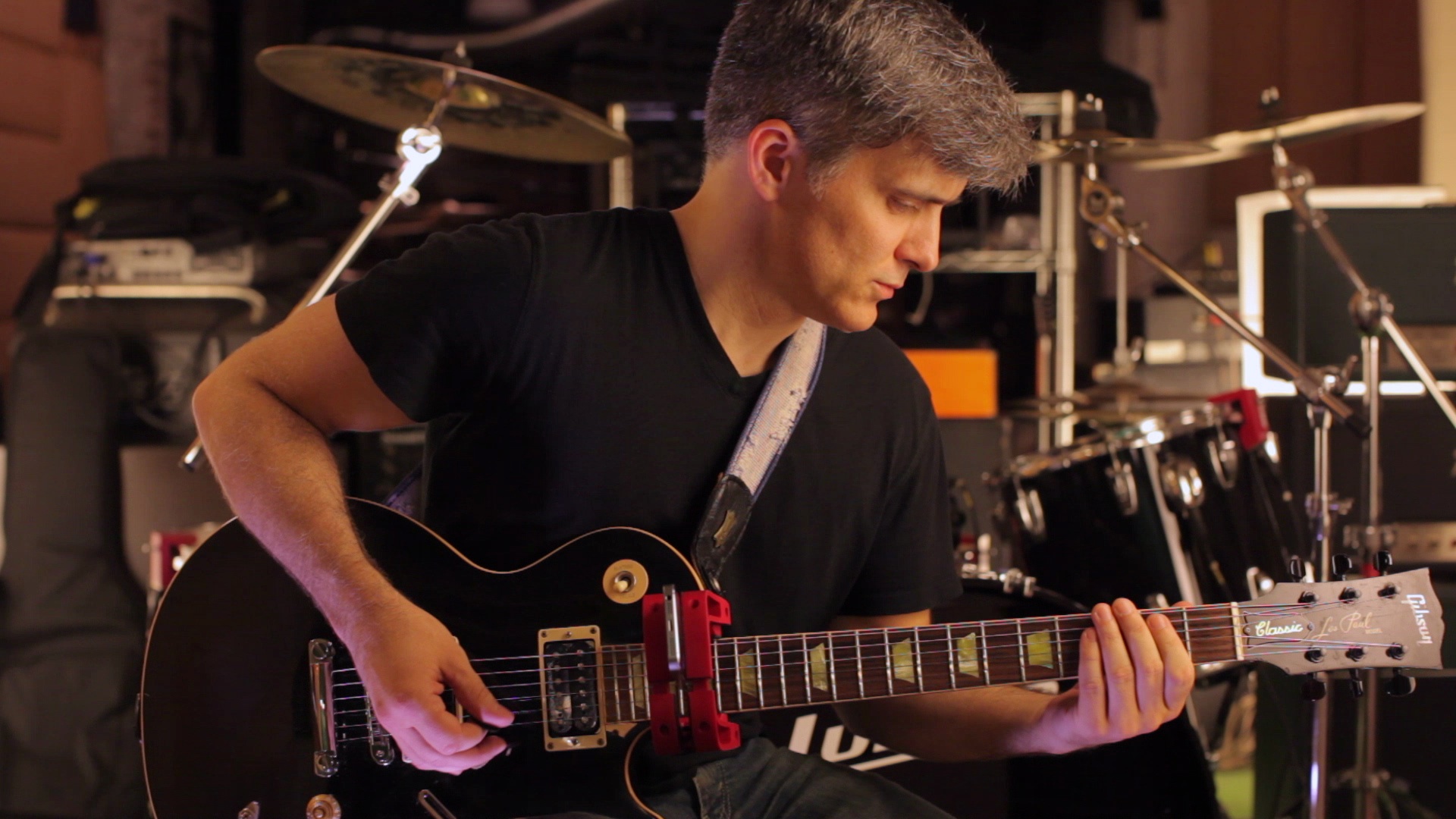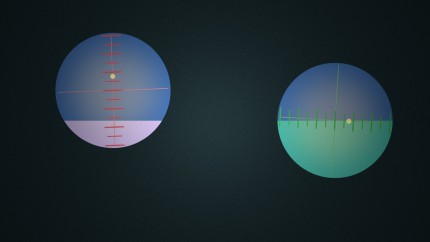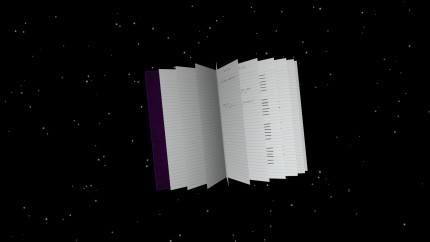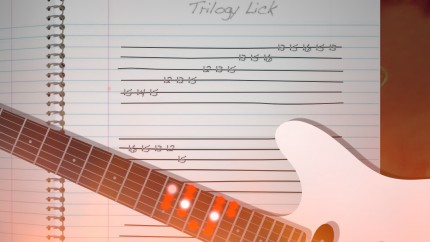
Bruce Lee’s famous exhortation to be like water may just as well have been directed at guitar players. The first of Season 2’s revelations, downward pickslanting, is shapeless and formless. It becomes Yngwie. It becomes rock. It becomes music. It’s one of the most universal and adaptable mechanics in picking — and for guitarists, the root of many of the most celebrated techniques in history.
The Down Around the World download isn’t currently available — but you can find several other free downloads in our online store!
The Bottleneck
As a concept, pickslanting embodies the solution to the central problem in all of fast guitar playing: switching strings. It is precisely this, and not actual speed, that is the primary bottleneck in developing elite picking technique. And this has historically been a source of great confusion among guitarists. Most people have no trouble moving their hands quickly enough to be impressive players. It’s doing so with accuracy that turns out to be the real challenge. This becomes evident at thresholds well below those of Flight Of the Bumblebee daredevils. And it’s precisely the task of moving from string to string that causes this.
Mind the Gap
Beginners on the instrument intuitively sense the dilemma, if not its solution. I still remember this feeling vividly. In 1985, a few months after bringing home the white Ibanez from the local Sam Ash, I had already begun the rite of passage, seemingly unchanged to this day, of methodically dismantling the guitar parts on Van Halen’s first album.
 Fumbling with the mix of single notes and double stops on the opening riff to “Feel Your Love Tonight”, I was both encouraged and humbled. The muted pedal tones, which I would soon learn were the currency of ’80s rock rhythm playing, were easy enough to hit. There was nothing on top of them! Because they happened on the low E string, you didn’t need technique so much as velocity. By swinging at them blindly, it was like hitting a redwood with an axe — you couldn’t miss. But the melody notes on the A string were a different story. The gap between E and A strings was all of a quarter inch wide. But it may as well have been Snake River Canyon because there was no way I was getting across.
Fumbling with the mix of single notes and double stops on the opening riff to “Feel Your Love Tonight”, I was both encouraged and humbled. The muted pedal tones, which I would soon learn were the currency of ’80s rock rhythm playing, were easy enough to hit. There was nothing on top of them! Because they happened on the low E string, you didn’t need technique so much as velocity. By swinging at them blindly, it was like hitting a redwood with an axe — you couldn’t miss. But the melody notes on the A string were a different story. The gap between E and A strings was all of a quarter inch wide. But it may as well have been Snake River Canyon because there was no way I was getting across.
My hand was like a shovel trying to dig its way into to a tiny crack in the sidewalk. How do I get the pick in there? Even then, the problem was clear enough. Picking a note on a string involves, somehow, inserting the pick between two of them. Then you pluck the chosen string, by way of a reciprocating sequence of upstrokes and downstrokes which we now know as alternate picking.
I actually understood this part without explanation, even before the Ibanez had arrived. In fifth grade, one of the neighborhood kids had dropped “Eruption” on the turntable in his bedroom, and mimicked its famous tremolo sequence on a beaten up acoustic. He was surprisingly fast. He wasn’t a guitar player — he was a football player. I was beginning to understand that high-speed back and forth movements, like the shuttle run in the President’s Physical Fitness Test, were the province of the athletically gifted.
Enemy Mine: Stringhopping
 But changing to a new string took more than speed. This meant lifting the pick back out of the trench, and repeating the plunge between two different strings. Playing fast meant doing this maneuver at ever-increasing speeds, like a sewing machine.
But changing to a new string took more than speed. This meant lifting the pick back out of the trench, and repeating the plunge between two different strings. Playing fast meant doing this maneuver at ever-increasing speeds, like a sewing machine.
At elevated tempos, the machine quickly broke down. The repeated lifting and dropping of the pick from string to string resulted in an aggressive and exhausting pecking motion which we know from Cracking the Code as stringhopping. And stringhopping isn’t just slow — it’s also unreliable. The jumping decouples the picking hand’s spatial and tactile reference points, making it harder to tell by feel where your pick is located. The difficulty of accurately targeting the correct string only increases as the frequency of the string changes increases.
So this is what it was, and what it still is: a geometry problem. The strings, arrayed in a flat plane, are like tripwires we cannot cross lest we get tangled. If we play quickly, we make mistakes and get tired. If we play slowly, we fail to earn our spandex pants and fog machine glory.
Solving the Plane
 How do we solve the plane? The answer, as practiced instinctively by Yngwie and generations upon generations of gifted guitar athletes, is as ingenious as it is simple:
How do we solve the plane? The answer, as practiced instinctively by Yngwie and generations upon generations of gifted guitar athletes, is as ingenious as it is simple:
On an angle.
The two movements of alternate picking — the plucking of a string, and the diving into and out of the plane of the strings — can be perfectly conflated into one streamlined shuttle run by simply aligning their trajectories. By rotating the picking hand, like turning a doorknob, stringhopping’s vertical spring is brought into confluence with the pendulum of alternate picking. Both movements, operating now perfectly in phase, oblique to the plane of the strings, split their responsibilities: Every downstroke pierces the plane. Every upstroke leaves it.
Downstroke, upstroke. Enter, exit.
Beguilingly Simple, Incredibly Powerful
 As a mechanical solution, downward pickslanting is an engineer’s dream. Simple, elegant, flexible, and cheap. It provides a system for traversing an unlimited number of of parallel strings in any direction with almost no extra movement, and very little extra training. The one constraint — that you change strings only after upstrokes — turns out to be far less restrictive than it sounds. Through a clever gerrymandering of fretboard shapes, an enormous vocabulary of musical expression unfurls within this upstroke framework. Indeed, because of the nearly universal distribution of downward pickslanting formulas across musical styles, this vocabulary includes many of the guitar’s most cherished clichés. In some sense, phrases born of downward pickslanting requirements have contributed to the very meaning of “guitaristic” style and sound.
As a mechanical solution, downward pickslanting is an engineer’s dream. Simple, elegant, flexible, and cheap. It provides a system for traversing an unlimited number of of parallel strings in any direction with almost no extra movement, and very little extra training. The one constraint — that you change strings only after upstrokes — turns out to be far less restrictive than it sounds. Through a clever gerrymandering of fretboard shapes, an enormous vocabulary of musical expression unfurls within this upstroke framework. Indeed, because of the nearly universal distribution of downward pickslanting formulas across musical styles, this vocabulary includes many of the guitar’s most cherished clichés. In some sense, phrases born of downward pickslanting requirements have contributed to the very meaning of “guitaristic” style and sound.
The salient characteristic of such phrases, and the logical implication of upstroke string changes, is that they will be constructed of an even number of notes per string. This flows naturally from the binary nature of our compromise with stringhopping. Since we can only exit the plane of the strings every other pickstroke, it follows that the number of notes we can play on any string will always be evenly divisible by two.
However there’s an escape clause. If we can start the first string of a passage on an upstroke, we can then play an odd number of notes on that string and still finish on an upstroke. Because melodic lines are not strictly metronomic, ebbs in their rhythmic flow offer many opportunities to do exactly that. Like a hockey player coming off the bench, starting a new melody after a timeout gives us the freedom to start on an upstroke. We can play an odd number of notes on the initial string, fully picked, with all the advantages that downward pickslanting normally confers.
A Trilogy of Notes
We discuss precisely this scenario in Season 2, Episode 1 in the context of Yngwie’s descending Trilogy-shape scale lick. Yngwie normally initiates the pattern with a legato sequence on the top string. It’s an artistic call, but also a mechanical one. The sequence is three notes long, and given Yngwie’s penchant for starting phrases on downstrokes, this would of course be problematic. A three-note-per-string sequence that starts on a downstroke will also end on one, causing the first string to terminate at odds with with our upstroke formula. But you can reverse this situation by instead starting the lick on an upstroke. This will cause the first string also to end on an upstroke, and connect perfectly to the rest of the lick. In this way, you can wring more picked notes out of an initially problematic fretboard arrangement.
Of course Yngwie’s actual approach is different still. By instead using legato, he makes an end-run around the entire issue. After initiating the legato sequence with a downstroke, he can simply lift his pick to the next string of the lick. Once there, he waits for the melodic flow to arrive. And when it does, he’s ready with a downstroke to begin picking anew.
The lifting movement between the first two strings of Yngwie’s famous descending scale lick is technically stringhopping. But it’s happening only once, in controlled fashion, with plenty of time to get from the first string to the second. Ironically, this makes stringhopping itself a legitimate component of downward pickslanting strategies, in a “timeout” case like this. The extra time effectively resets the mechanical flow of the picking pattern, and even allows for phrases on new strings to begin on upstrokes.
Legato Escape
 The trilogy lick also highlights a second escape clause in the Yngwie downward pickslanting formula: legato.
The trilogy lick also highlights a second escape clause in the Yngwie downward pickslanting formula: legato.
An inefficient downstroke string change can be transformed into a perfectly efficient pickslanting string change through the simple insertion of one unpicked note at the end of the pickstream on a given string. This terminates the picking hand’s responsibilities on the previous note — an upstroke — exiting the plane of the strings gracefully by way of downward pickslanting. Both the G and the D strings of Yngwie’s descending lick do precisely this. The first two notes on each string are picked, followed by a pull-off for the third note — thus engineering two-note-per-string picking from a three-note sequence. Of course the legato note also adds more time for the right hand to make the switch from one string to another. But in this case it’s the upstroke, and not the timeout, that is the primary source of the efficiency.
Sweeping on Through
 If all this weren’t enough, Yngwie’s got one more escape pod at his disposal. And it’s a big one: sweeping. Sweeping always follows the direction of the pickslant, which you already know if you’ve ever watched Frank Gambale play. The broom-like rotational wrist swishing from upsweep to downsweep and back is a hallmark of the technique, and the very source of its name. In some sense, it can be said that sweeping isn’t even really a technique, so much as a particular case of alternate picking where the picking frequency is simply slower than the frequency of string change. Wild. But let’s not get ahead of ourselves.
If all this weren’t enough, Yngwie’s got one more escape pod at his disposal. And it’s a big one: sweeping. Sweeping always follows the direction of the pickslant, which you already know if you’ve ever watched Frank Gambale play. The broom-like rotational wrist swishing from upsweep to downsweep and back is a hallmark of the technique, and the very source of its name. In some sense, it can be said that sweeping isn’t even really a technique, so much as a particular case of alternate picking where the picking frequency is simply slower than the frequency of string change. Wild. But let’s not get ahead of ourselves.
Because Yngwie is a downward pickslanter, it follows that his sweeping is downward. What this means for string change efficiency is that we now have a way of switching strings after downstrokes that incurs no mechanical penalty. How do you move from one string to another without exiting the plane of the string? To quote a lyric, you break on through to the other side. By simply continuing the final downstroke on a given string, you sidestep our contract with stringhopping, and initiate picking on the next higher string with the same downstroke.
Playing by the Rules
 We’ll explore Yngwie’s use of sweeping further in Season 2, Episode 2, “Inside the Volcano”. In that episode, we’ll outline the entirety of Yngwie’s powerful and fascinating asymmetrical picking strategy, and delve deeper into its implications. But the simple system of rules we’ve already outlined provides incredible power to start thinking and playing like a picking legend. Let us count the ways:
We’ll explore Yngwie’s use of sweeping further in Season 2, Episode 2, “Inside the Volcano”. In that episode, we’ll outline the entirety of Yngwie’s powerful and fascinating asymmetrical picking strategy, and delve deeper into its implications. But the simple system of rules we’ve already outlined provides incredible power to start thinking and playing like a picking legend. Let us count the ways:
- At heart, we have the core downward pickslanting (or dwps) picking strategy, which enables clean switching after upstrokes.
- We can choose optimal fingerings to enable even-numbered note groupings.
- We can use isolated legato notes — frequently pull-offs — to convert odd-numbered note groupings to even ones when necessary.
And we have at least three techniques for playing odd-numbered note groupings:
- We can use controlled stringhopping during timeouts in the rhythmic flow of a line, when there is enough time to do so.
- We can start new strings on upstrokes during those gaps, or at the beginning of new phrases.
- And we can use downward sweeping to move to higher strings on downstrokes.
This all sounds more complex than it really is. Over time, you’ll actually be able to skillfully improvise within this ruleset much as you do in normal conversation. Much like the gaps between the strings, which seemed to expand as your ability grew, everything you currently know was once alien and strange.
And let’s not forget: there’s also the possibility that you do a good deal of this already. These techniques don’t exist by accident. They are the natural result of human intuition faced with a universal set of mechanical challenges. If you’re already an experienced downward pickslanter — or perhaps, just discovering that you are — welcome to the club. It’s time to take more explicit, conscious ownership of these amazing abilities.
Down Around the World
 In the “Down Around the World” series you will see and hear all of these techniques in the service of a selection of classic musical styles. The mechanical possibilities are as wildly diverse as the sounds. The motion mechanics, string tracking mechanics, anchoring mechanics, and edge picking mechanics involved are all topics for further discussion. But these short musical ideas should present more than enough grist to get the mechanical mill started.
In the “Down Around the World” series you will see and hear all of these techniques in the service of a selection of classic musical styles. The mechanical possibilities are as wildly diverse as the sounds. The motion mechanics, string tracking mechanics, anchoring mechanics, and edge picking mechanics involved are all topics for further discussion. But these short musical ideas should present more than enough grist to get the mechanical mill started.
Slow motion footage and tablature for all the clips in Down Around the World are available for a few bucks. A greater wealth of musical and mechanical ideas — a veritable supermarket of downward pickslanting formulas — you will not find anywhere else. Go ahead and give it a shot. Of course, if you’re already the proud holder of a Season 2 pass, then you’ve already got this and so much more coming your way.
Be Like Water
We’re used to associating mechanical techniques with sounds: the aggressiveness of muted alternately picked scales; the fluidity of swept arpeggios. But these qualities actually aren’t inherent to the techniques: they’re creative choices. Indeed, part of why Yngwie’s picking ability has remained so mysterious, even to this day, stems from the incredible artfulness of his execution. That dramatically muted, absolutely molten ascending scale break in Now Your Ships Are Burned, so often quoted in Cracking the Code, still ranks among the most astonishingly aggressive moments in recorded guitar history. That it was actually done with sweeping only underscores the role of musical intent in mechanical decisions.
 When performed correctly, picking techniques possess only the sonic characteristics you give them. Your listeners shouldn’t hear your mechanics any more than visitors to your home should see your plumbing. Flawless though the joints on those copper elbows may be, the creator is likely the one who will ever see them.
When performed correctly, picking techniques possess only the sonic characteristics you give them. Your listeners shouldn’t hear your mechanics any more than visitors to your home should see your plumbing. Flawless though the joints on those copper elbows may be, the creator is likely the one who will ever see them.
The huge community of stringed instrument players around the world who make incredible, distinctive music with dwps formulas is a testament to this. Picking mechanics flow from the geometry inherent to nearly all plectrum-based instruments: strings arrayed in a flat plane, pick diving and slashing between them. So it’s no surprise that those instruments all function similarly. Mandolin, bouzouki, oud, cuatro, balalaika, laúd — they all work this way, and the list goes on. Each of these instruments possesses a personality supported by decades if not centuries of musical culture. And that is where the artistry resides.
Downward pickslanting is an amazing engineering achievement. But it wasn’t designed by engineers. It’s a limitless creative tool, used by players throughout time, in every conceivable endeavor. For a technique whose protean nature adapts so effortlessly to the creative will, it seems only fitting that the artists who use it have been largely unaware they were doing so. It’s an invisible paintbrush, filled with every watercolor you can imagine, and it never runs dry.
Be like water, indeed.
